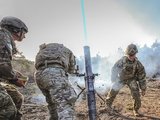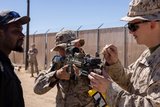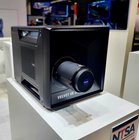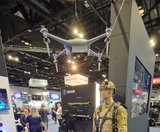Cubic tailors mortar simulator for the US Army
The company’s mortar trainer received improvements based on soldier’s feedback.
MetaVR's Virtual Reality Scene Generator (VRSG) has been integrated into the US Air Force’s T-1A Jayhawk twin-engine jet trainer fleet, part of an embedded training device being used to provide a simulated mixed reality electro-optical/infrared (EO/IR) training capability for the aircraft.
USAF’s Combat Systems Officer (CSO) training station at Naval Air Station (NAS) Pensacola in Florida has purchased 49 MetaVR VRSG licenses, which will be installed on 21 T-1A Jayhawk training aircraft at the base.
VRSG forms part of the T-1A Combat System Officers Training System (CSOTS) embedded training device for the aircraft, which is used to train students in the operation of EO/IR sensors.
The system generates the visuals for the system, resulting in a mixed reality training experience for trainees, combining simulated and live environments.
In-flight EO/IR training is carried out using a generic simulated sensor model similar to the L3 Wescam MX-20 pod.
A total of 15 flight paths between North Carolina and Louisiana can be flown during training exercises, with correlated views displayed on MetaVR's SE CONUS ++ terrain.
The system is integrated with a third party computer-generated/semi-automated forces application so that students can see a replicated target inserted into the simulated view, which are buildings, ground vehicles or other aircraft models from MetaVR's model libraries.
‘The training environment is truly mixed reality – students looking out the aircraft window see real-world locations that correlate with the simulated sensor views of MetaVR's geospecific 3D terrain rendered in VRSG software,’ Garth Smith, president of MetaVR, said.
‘The major benefit here is that the students obtain maximum training value by flying a real platform and benefitting from having a sensor view that correlates to their actual geographic location.’
The sensor simulation approach helps reduce overall training costs to USAF by providing an alternative to more expensive EO/IR sensors, and two VRSG licenses are installed on each of the 21 aircraft.
One of these is used to display content in front with the co-pilot, the other used for the student situated behind them.
In addition to the aircraft-based training system, VRSG is used on a ground-based trainer to increase student's familiarisation with the training, and to provide the ability to play back missions in a debrief setting..
The T-1A CSOTS is the first course of a one and a half year-long CSO training course, and after this, students go on to electronic warfare classroom training on the T25 Simulator for Electronic Combat Training - a classified system that also uses VRSG - followed by training on the T-6A Texan II trainer aircraft.

The company’s mortar trainer received improvements based on soldier’s feedback.

The company will operate in two new locations in the coming years to better support US services.

This type of tool provides more realistic training easing the incorporation of new scenarios that accurately represent the threats of the battlefield.

The Engineering Corps has been conducting individual instruction using FLAIM Systems’ Sweeper and should start collective deployments in 2025.

The next-generation platform is motion-compatible and can be used in OTW and NVG applications.

The system can be used to prepare soldiers for both drone offensive operations and CUAS missions.